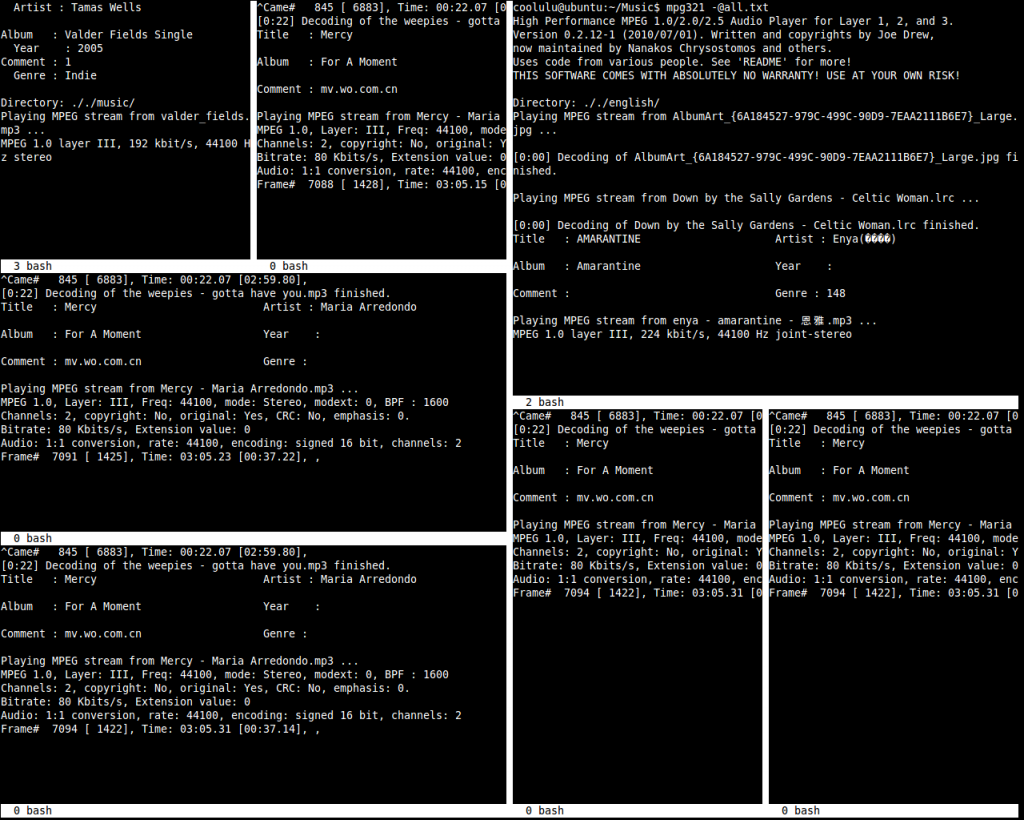把装逼进行到底!提高生活质量,多用键盘,不买鼠标!
同时开了七个mpg321放不同的歌叫起床,声音好混乱啊~

find > list.txt
A: mpg321 -@list.txt -zZv -l 0
C^c = next
C^\ = quit
B: mpg321 -@list.txt -zZ -l 0 &
killall mpg321
-------------------------------------------------------------------------------
MPG321(1) MPG321(1)
NAME
mpg321 — Simple and lighweight command line MP3 player
SYNOPSIS
mpg321 [options] file(s) | URL(s) | -
DESCRIPTION
mpg321 is a free command-line mp3 player, which uses the mad audio
decoding library. mpg321 was written to be a drop-in replacement for
the (by-then) non-free mpg123 player. Some functions remain unimple‐
mented, but mpg321 should function as a basic drop-in replacement for
mpg123 front-ends such as gqmpeg, and those programs which use mpg123
to decode mp3 files (like gtoaster, and other CD-recording software).
OPTIONS
-o devicetype
Set the output device type to devicetype. devicetype can be
one of:
oss - the Linux Open Sound System;
sun - the Sun audio system;
alsa - the Advanced Linux Sound Architecture;
alsa09 - the Advanced Linux Sound Architecture, version 0.9;
esd - the Enlightened Sound Daemon;
arts - the analog real-time synthesiser
See -a device, below.
-a device, --audiodevice device
Use device for audio-out instead of the default device,
depending on the output device you've chosen (via -o device‐
type). By default this is the native sound device. Gener‐
ally this is the device for devicetype (or the default system
device) to use for output (i.e. /dev/sound/dsp1).
This option has no effect with -o arts.
For -o esd, specify the host on which esd is running;
defaults to localhost.
For -o alsa, specify card:device; defaults to 0:0.
-g N, --gain N
Set gain (volume) to N (1-100).
-k N, --skip N
Skip N frames into the file being played.
-n N, --frames N
Decode only the first N frames of the stream. By default, the
entire stream is decoded.
-@ list, --list list
Use the file list for a playlist. The list should be in a
format of filenames followed by a line feed. Multiple -@ or
--list specifiers will be ignored; only the last -@ or --list
option will be used. The playlist is concatenated with file‐
names specified on the command-line to produce one master
playlist. A filename of '-' will cause standard input to be
read as a playlist.
-z, --shuffle
Shuffle playlists and files specified on the command-line.
Produces a randomly-sorted playlist which is then played
through once.
-Z, --random
Randomise playlists and files specified on the command-line.
Files are played through, choosing at random; this means that
random files will be played for as long as mpg321 is running.
-v, --verbose
Be more verbose. Show current byte, bytes remaining, time,
and time remaining, as well as more information about the mp3
file.
-s, --stdout
Use standard output instead of an audio device for output.
Output is in 16-bit PCM, little-endian.
-w N, --wav N
Write to wav file N instead of using the audio device. This
option will be preferred if --cdr or --au are specified too.
Specifying '-' for N will cause the file to be written to
standard output.
--cdr N Write to cdr file N instead of using the audio device. Speci‐
fying '-' for N will cause the file to be written to standard
output.
--au N Write to au file N instead of using the audio device. Speci‐
fying '-' for N will cause the file to be written to standard
output.
-t, --test
Test mode; do no output at all.
-q, --quiet
Quiet mode; suppress output of mpg123 boilerplate and file
and song name.
-B Read recursively the given directories. Allows you to define
only the directory or directories and then mpg321 recursively
plays all the songs.
-F Turn on FFT analysis on PCM data. Remote mode only
-S Reporting song to AudioScrobbler (last.fm).
-R "Remote control" mode. Useful for front-ends. Allows seeking
and pausing of mp3 files. See README.remote (in
/usr/share/doc/mpg321 on Debian and some other systems.)
--stereo Force stereo output: duplicates mono stream on second output
channel. Useful for output for devices that don't understand
mono, such as some CD players.
--aggressive
Aggressive mode; try to get higher priority on the system.
Needs root permissions.
--skip-printing-frames=N
Skip N frames between printing a frame status update, in both
Remote Control (-R) and verbose (-v) mode. Can help CPU util‐
isation on slower machines. This is an mpg321-specific
option.
-l N, --loop N
Loop song or playlist N times.If N is 0 means infinite times.
--help, --longhelp
Show summary of options.
-V, --version
Show version of program.
AUTHOR
This manual page was written by Joe Drew <drew@debian.org>.
Maintained by Nanakos Chrysostomos <nanakos@wired-net.gr>.
Permission is granted to copy, distribute and/or modify this document
under the terms of the BSD license. On Debian systems, this can be
found in /usr/share/common-licenses/BSD.